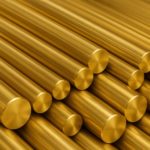BRASS
Main alloys

Brasses are characterised by an alloy primarily of copper with a zinc content ranging between 5% and 35%. The zinc content influences the colour of the alloy (from golden-yellow to red) and its mechanical properties. In watchmaking, a zinc content close to 30% is ideal. It is optimal for the alloy’s machinability, making it suitable for cutting, stamping, or engraving.
Variation of brasses
Brasses can be classified into three main categories:
- Simple brasses, or binary alloys, consist exclusively of copper and zinc. Increasing the zinc content enhances the hardness and mechanical strength of the brass while lowering its melting point and electrical conductivity.
- Lead brasses (containing 1-3% lead) are highly valued in horology for their excellent machinability and optimal chip removal, resulting in superior surface finishes. However, due to their pollutant nature, the use of such alloys is restricted and may be phased out due to the implemented REACH regulations in Europe.
- Special brasses incorporate one or more additional elements. For instance, adding nickel improves the alloy’s resistance to corrosion.
Specificity of application
In addition to being ductile and malleable, brasses exhibit good corrosion resistance. Upon exposure to air, a greenish patina (verdigris) forms on the surface due to copper oxidation. Furthermore, brasses are non-magnetic, electrically conductive (suitable for electro-erosion), and provide an excellent substrate for various surface treatments (such as galvanic treatments, physical vapour deposition, lacquers, varnishes, etc.).
Brass has been known since prehistoric times, but it wasn’t until the Roman era (circa 100 BC) that its production was refined and deliberately undertaken. It was notably used for minting coins, such as Roman sesterces. From the Middle Ages onwards, its use expanded to include the making of cauldrons, tableware, and boilers. Due to its properties—ductility, malleability, and corrosion resistance —brass has historically and enduringly been a favoured alloy among watchmakers.
Brasses are highly prized in the manufacture of movement components. In most watches, the bridges and mainplate are machined from this alloy. Consequently, many watchmakers commonly refer to the bridges and mainplate as “the brasses.” Certain pins or settings may also be made of brass, which, due to its malleability, is well-suited for forging and driving. Lastly, the wheels’ plates are typically made from this alloy, offering, when in contact with the steel teeth of a pinion, the optimal friction coefficient to minimise energy loss within the gear train.
Many tools and machines are wholly or partially made of brass (e.g., tweezers, face lathes, screwdrivers, etc.).
